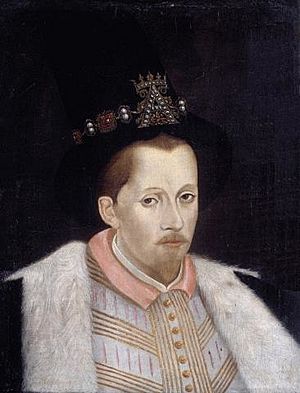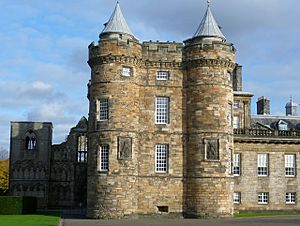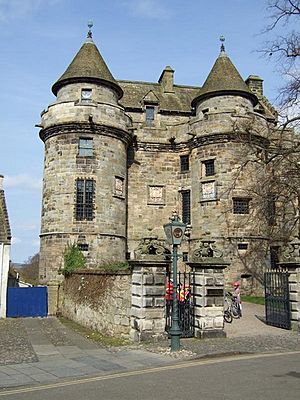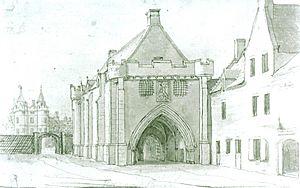Raid of Holyrood facts for kids
The Raid of Holyrood was an attack on Holyrood Palace in Edinburgh on 27 December 1591. It was led by Francis Stewart, 5th Earl of Bothwell. He wanted to gain the favour of King James VI of Scotland or even kidnap him. Bothwell later tried to attack Falkland Palace and made another attempt at Holyrood in July 1593.

Contents
Why Bothwell Attacked the King


Francis Stewart, Earl of Bothwell, was a nephew of Mary, Queen of Scots. He lost the trust of King James VI. Bothwell was even accused of using witchcraft during the North Berwick witch trials.
After being forced away from the King's court, Bothwell tried to break into Holyrood Palace twice. He also tried to capture Falkland Palace once. His goal was either to get back into the King's good graces or to kidnap him. Bothwell had many loyal followers among Scottish landowners. Despite this support, he was eventually forced to leave Scotland and died in Naples in 1612.
First Attack on Holyrood: December 1591
The first attack on Holyrood Palace happened on Monday, 27 December 1591. Bothwell arrived with about sixty followers after supper. Among them were important landowners like James Douglas of Spott and Archibald Wauchope of Niddrie.
One of Bothwell's men, James Douglas of Spott, went to free his servants. They were held in the palace gatehouse, suspected of a murder. This gatehouse was once a workshop but was now used as a prison. One man had been hurt there on Christmas Day. Spott's actions raised the alarm much faster than Bothwell's group wanted.
The King and his courtiers quickly blocked themselves inside the palace. Harry Lindsay of Kinfauns helped them. Meanwhile, Andrew Melville of Garvock and Sir James Sandilands went to get help from outside.
King James VI and Anne of Denmark went to the palace tower. Most of the court was still eating supper in the great hall. They blocked the doors against Bothwell's men until help arrived from the people of Edinburgh. Bothwell's men tried to break in with hammers and burn doors. The King's chief advisor, John Maitland, was trapped in his room. Harry Lindsay defended the Queen's door. Both the King and Queen were safe in the tower, which had a strong iron gate.
A shot from Maitland's window killed one of Bothwell's men. Another attacker was also hit. The King's courtiers fought back with sticks and other weapons. Bothwell's men used the darkness to escape through the stables. Seven of Bothwell's men were caught and hanged. Queen Anne of Denmark successfully asked King James VI to spare some of them, especially John Naysmyth.
The Schaw Brothers
During the fight, Archibald Wauchope of Niddrie was shot in the hand. This was done by John Schaw, one of the King's horsemen. John Schaw and his twin brother Patrick were badly hurt in the stables. A poet named Alexander Montgomerie wrote a poem about them.
Who Was Suspected?
It was said that during the raid, Bothwell's wife, Margaret Douglas, Countess of Bothwell, waited nearby. She had jewels and money ready for the captured queen. But she left secretly in fear after the attack failed. The King's Privy Council later banned her from seeing the King.
Some people suspected the Duke of Lennox. One of his men took part in the raid and then ran away. The King's chief advisor, Maitland, did not trust Lennox. A list of fifty people suspected of being in the raid included Bothwell's half-brother, Hercules Stewart. King James VI announced that he would punish those who rode with their faces covered and disguised.
Elizabeth I of England congratulated Queen Anne of Denmark for escaping Bothwell's "wicked plan." She told Anne to encourage King James VI to punish the attackers. In England, it was heard that Bothwell wanted to kill Maitland. King James VI then promised Bothwell's lands and goods to the Duke of Lennox to get his support.
Attack on Falkland Palace: June 1592
On 28 June, between 1 and 2 in the morning, Bothwell tried to capture Falkland Palace and the King. He had 300 followers. But the King, Queen, and their closest courtiers were warned. They went into the tower and locked it from the inside. Bothwell's main attack was at the back gate near the tennis court. The defenders fired at his men from the tower.
Bothwell gave up and left, taking horses from the royal stables. English border raiders, including Richie Graham and Thomas Musgrave, then robbed Falkland town. They took horses, clothes, and money. On 29 and 30 June, orders were given to chase Bothwell and arrest his helpers.
According to Sir James Melville of Halhill, he and his brother knew about the plan to capture the King and Queen at Falkland. They advised the royal couple to ride north to Ballinbreich Castle for safety. But this advice was not followed. Instead, the Melville brothers were told to ride south to get more help for Falkland. They found out Bothwell was very close and sent a servant back to Falkland. At first, his story was not believed. When he came back a second time, he was believed. So, the royals moved into the gatehouse tower for extra safety.
King James VI returned to Edinburgh. On 5 July, he wrote to Elizabeth I about the Falkland raid. He promised to hunt down the attackers. He asked her to pursue any fugitives in England and any English people who were involved. He also asked her for money to help.
Second Attack on Holyrood: July 1593
On Tuesday, 24 July 1593, the Earl of Bothwell, in disguise, managed to get into Holyroodhouse. He was helped by Marie Ruthven, Countess of Atholl. She had access to a back gate that led to her mother's house.
It was said that Bothwell hid behind a tapestry until the right moment. Accounts say the King was in his private room. According to John Spottiswoode, King James VI saw Bothwell's sword. The King said, "Strike Traitor! and finish your work, for I do not want to live any longer." Bothwell knelt and offered his sword to the King, saying the King could cut off his head if he wished. James refused. Soon, many of Bothwell's supporters also entered the room.
Bothwell told his version of this conversation to William Reed. When James saw Bothwell, he said, "Francis, you will do me no harm!" Bothwell knelt and offered his sword. The Duke of Lennox and the Earl of Atholl came into the room. They spoke for Bothwell, saying he was a noble relative who would not harm the King. They said the King needed Bothwell's help for important matters. According to Bothwell, the King forgave him.
The leader of Edinburgh, Alexander Home, came to the palace to help. But the King said everything was fine. Bothwell told Home to leave. Other noblemen were present. Lord Ochiltree offered to fight Bothwell over the killing of his brother in 1588. But there was no fighting. The King accepted Bothwell's promises of loyalty. They agreed to pardon him from charges of treason. However, Bothwell never regained the King's full favour and eventually went into exile.
Two Danish ambassadors were in Edinburgh during this raid. They were staying near the palace. They wrote about the events in their journal. King James VI had to explain Bothwell's appearance at Holyrood to them. The Danish ambassadors had another meeting with King James VI in the palace garden the next day.
The English ambassador, Robert Bowes, thought that Marie Ruthven, Countess of Atholl, was a good friend to Elizabeth I. He advised Elizabeth to send her a jewel as a sign of support. For extra safety, the King's favourite, Sir George Home, was now staying in the house by Holyrood. Some people unfairly accused Queen Anne of Denmark of trying to help Bothwell reach the King.


